
Fothergilla: planting, pruning and care
Contents
Fothergilla in a nutshell
- Only two species exist: Fothergilla major or “large fothergilla” and Fothergilla gardenii or “dwarf fothergilla”
- They are magnificent deciduous and hardy bushes
- They are prized for their white spring flowering in fragrant bottlebrush spikes and for their foliage with spicy colours in autumn
- They thrive in sun or partial shade and in acidic soil, known as ericaceous soil, definitely not calcareous
- With very slow growth, they are used in borders or in pots
A word from our expert
Fothergillas are bushes still rather unjustly little known to amateur gardeners. With their white, distinctive spring flowering, in small, delightfully scented bottlebrushes and their flamboyant autumn foliage, they nevertheless create light, delicate scenes that are out of the ordinary.
Modest in size and slow in growth, Fothergillas nevertheless find their place in every garden, in beds or in pots, particularly in small gardens.
Their unique spring flowering and their foliage, which also guarantees a show in autumn by turning gold, copper and red, are real assets for these elegant, charming bushes.
With good hardiness, Fothergilla major and F. gardenii are accommodating in non-scorching sun or partial shade, in neutral to acidic, lime-free soil, fresh but well drained.
Discover our large or dwarf Fothergillas and be won over; they will be the perfect companions for your heather soil bushes!
Description and Botany
Botanical data
- Latin name Fothergilla
- Family Hamamelidaceae
- Common name Fothergilla, Fothergille
- Flowering April-May
- Height 0.60 to 2.50 m
- Exposure Sun, partial shade
- Soil type Acidic
- Hardiness -15°C
Native to moist woods and turf moors of southeastern United States, Fothergilla is a bush belonging to family Hamamelidaceae, like close relative witch-hazel. Genus Fothergilla contains two species, Fothergilla gardenii, sometimes nicknamed “dwarf Fothergilla” and Fothergilla major (monticola). In recent years both have produced new hybrid varieties such as Fothergilla x intermedia and cultivars like ‘Blue Shadow’, ‘Blue Mist’ or ‘Red Licorice’.
Fothergilla has slow growth and forms a dense, highly ramified bush from base, with an ovoid or upright habit. Modest in size, with a well-defined silhouette, it is perfectly suited to small and medium gardens and, although it may send out some suckers, it never becomes invasive. The Fothergilla gardenii will rarely exceed 60 to 90 cm in all directions, while larger Fothergilla major will not exceed 2.50 m with nearly as much spread when mature.
Fothergilla surprises with its light, fragrant spring flowering. In March, April–May or June depending on climate, curious inflorescences appear as terminal spikes 2 to 5 cm long, emerging before leaves and dotting the still grey bare shoots, like small brushes. Petal-less flowers are made up of many long upturned stamens 1 to 3 cm long, set in a chartreuse-green calyx, forming cylindrical spikes reminiscent of small bottle brushes.
They are white, tending to chartreuse-green or yellow at start of flowering and sometimes tinged with pink or cream-white. Fragrant, they give off a delicious sweet honey scent that attracts pollinating insects and drives bees wild! They develop into ovoid capsules each containing a small shiny seed.
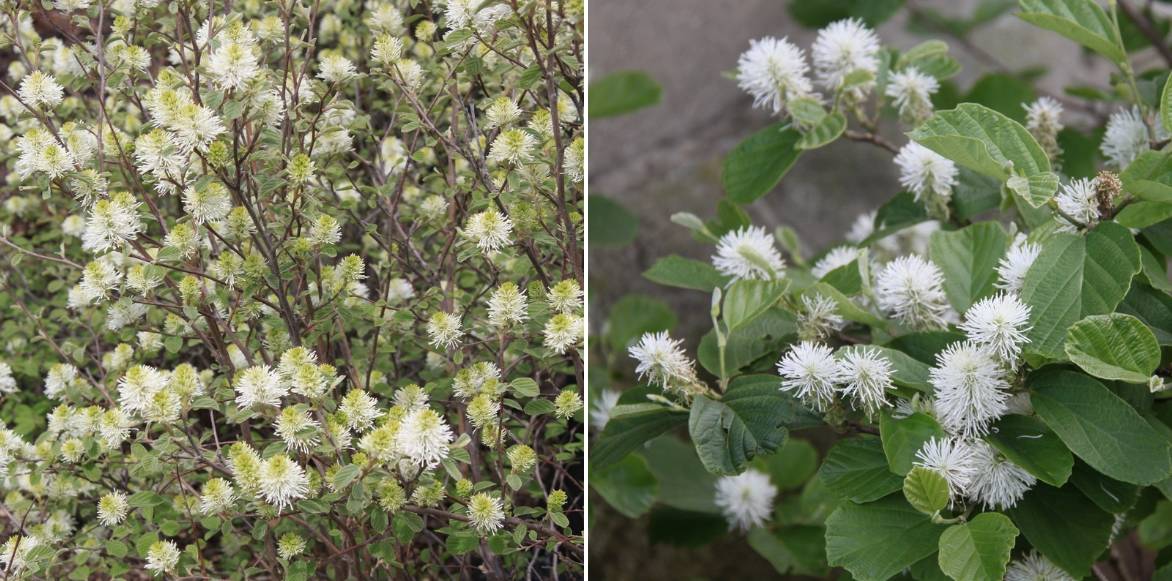
Flowering of Fothergillas: F. gardenii / F. major
This bush also charms with ornamental foliage that bursts into sumptuous autumn colours. Deciduous, its foliage consists of alternate leaves measuring 2 to 12 cm long, obovate to ovate or diamond-shaped, almost rounded, with dentate edges and well-marked parallel veins. Depending on variety, leaves may be glossy as if coated with wax or pubescent. With their puckered texture and sometimes slightly velvety underside, they resemble hazel leaves.
Green or a spectacular electric blue dusted with grey (‘Blue Shadow’) in spring, then turning dark green in summer, leaves take on autumn shades of fiery orange, scarlet red, cherry red (‘Red Licorice’), or copper streaked with purple-red zones, filling garden with warm, spicy colours before falling.
Perfectly hardy, Fothergilla can withstand temperatures around -15°C, sometimes lower, which ensures good resilience across regions.
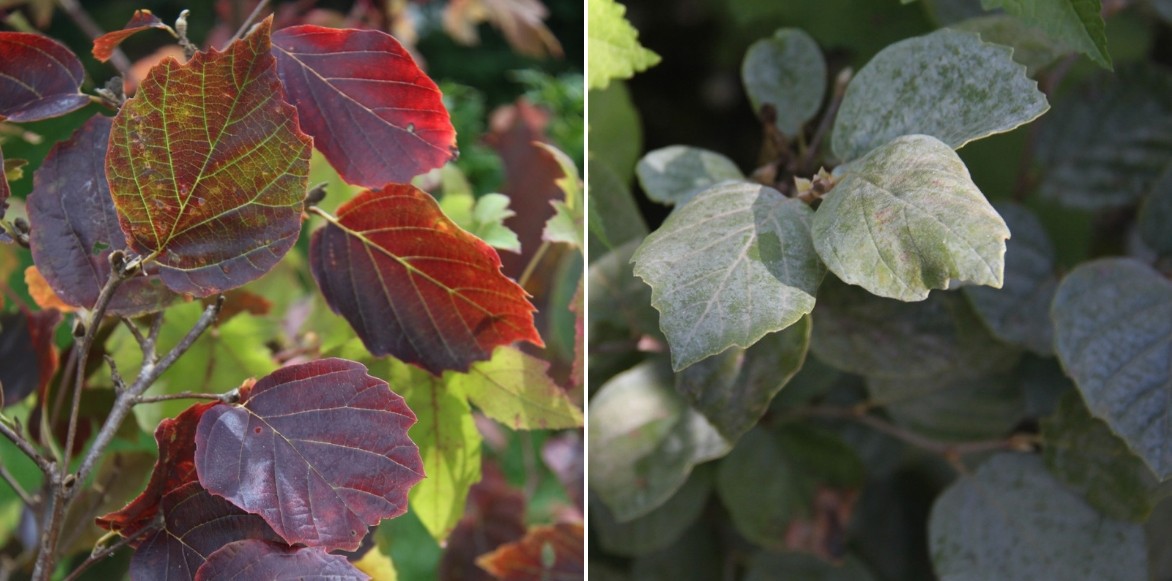
Autumn foliage of Fothergilla gardenii and steel-blue foliage of Fothergilla intermedia ‘Blue Shadow’
Easy to grow, it thrives in humus-bearing, acidic soil that does not dry out in summer but is well drained, in non-scorching sun or partial shade. Avoiding calcareous soils, this acidophilous plant is happy in heather soil. Ideally choose a cool spot, such as a clearing or light shade provided by other bushes.
Its modest size makes it ideal for small gardens, planted at centre of a cool border alongside ericaceous plants or in pots on terraces.
Read also
Plant young ericaceous plantsMain species and varieties
Only two species of Fothergilla are found: Fothergilla major (up to 2.5 m) or “grand Fothergilla”, which flowers in May–June, and Fothergilla gardenii, a sort of miniature fothergilla with earlier flowering (March–April or May depending on climate) and which, with its small size (1 m), fits into all gardens.
These two species have given rise to varieties such as ‘Red Licorice’, which display sumptuous autumn colours, from yellow to cherry red, and ‘Blue shadow’, a cultivar with bluish leaves in summer.
Most popular
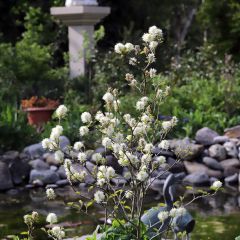
Fothergilla major
- Periodo de floración June, July
- Altura en la madurez 2 m

Fothergilla gardenii
- Periodo de floración May, June
- Altura en la madurez 75 cm
Our favourite
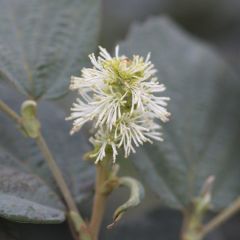
Fothergilla intermedia Blue Shadow
- Periodo de floración May, June
- Altura en la madurez 1,50 m
Planting
Where to plant Fothergilla?
The Fothergilla can be grown throughout France, except in Mediterranean climate, which is too hot and dry in summer, as this bush native to shrubby turf moors is highly intolerant of drought. With good hardiness, it withstands temperatures down to -15°C, sometimes lower, ensuring good resilience in less clement regions.
It likes sun, provided it is not too scorching, or light shade in southern France, for example under the canopy of deciduous trees: avoid dense shade so it flowers generously and provides sumptuous colours in autumn. Thus, in northern regions, plant in sun near a wall sheltered from drying winds to protect its fine flowering.
Intolerant of lime like its cousin Hamamelis and of dry soils, this acidophilous bush needs humus-rich, consistently cool soil and should be grown in neutral to slightly acidic soil, ideally in heather soil or in any non-calcareous soil enriched with potting compost.
Compact, Fothergilla finds its place in all gardens, whether large, medium or simple city gardens.
Alone or in groups of 3 or 5, it fits perfectly into sunny glades, in an informal flowering hedge with other spring-flowering bushes, in a bed of perennials or with heather-soil bushes, its white flowering standing out against a dark background of evergreen foliage.
Small varieties are perfect in low hedges and pots.

Bushy habit of Fothergilla major
When to plant Fothergilla?
Planting Fothergilla is preferably done in autumn, from September to November to encourage rooting before winter. Our potted Fothergilla can, however, be planted all year round, avoiding frosty periods or severe heat.
How to plant Fothergilla?
In open ground
Fothergilla dislikes calcareous soils but heather soil is not obligatory: it can adapt to ordinary non-calcareous soil enriched with potting compost. Heather soil should also be enriched with potting compost to ensure good development. If soil is too calcareous, better choose a bush less sensitive to soil type. If you still wish to try cultivation: add heather soil and forest potting compost. Plant alone or in groups of 3 or 5 at a rate of 1 plant per m2.
- Dig a wide planting hole at least three times the pot’s volume
- Add gravel to the base of the hole to ensure good drainage
- Plant Fothergilla at collar level, in a mix ideally composed of 1/5 loam mixed in equal proportions with turf, heather soil, leaf mould and coarse sand
- Keep its roots cool with an organic mulch of pine bark or fallen leaves
- Water regularly with non-calcareous water (rainwater), 2 to 3 times a week for the first three weeks after planting
Follow all our advice to succeed in planting your Fothergilla!
In a pot
Choose a dwarf Fothergilla whose compact growth habit suits this use perfectly. It will thrive for many years in a large container, provided regular watering.
- In a pot at least 30–40 cm in diameter, make a bed of gravel or clay balls at the bottom
- Plant your Fothergilla in a fresh, very free-draining mix based on pure heather soil, well-rotted compost and good non-calcareous garden soil
- Water very regularly with rainwater to keep the substrate consistently moist
- Spread a mulch or plant small perennials to help keep the base cool
Maintenance, pruning and care
Maintenance of Fothergilla is easy, it is undemanding when grown in suitable substrate, especially as it is a bush almost immune to most diseases. In short, it is vulnerable to only two things: dry soil and calcareous conditions.
If soil is too calcareous for it, the bush often suffers from chlorosis: foliage yellows and its flowering is reduced. Better to try transplanting it into a new planting hole before it dies, enriching the earth with heather soil and potting compost.
Regarding watering, young plants need very regular attention during first three summers after planting. In ground as in pot, soil must never dry out completely.
Closer monitoring of watering, especially during heatwaves or prolonged drought, preferably using rainwater, will be essential, as will a generous organic mulch (bark or pine needles, tapetum of leaves) to prevent soil drying out at its base.
This small bush requires little or no pruning; it consists of a very light tidy-up in spring in February–March, before growth resumes. This helps rebalance its habit :
- Remove dead, stubborn or tangled branches
- After flowering: remove faded flowers
To learn all about caring for heather soil bushes, consult our advice sheet.
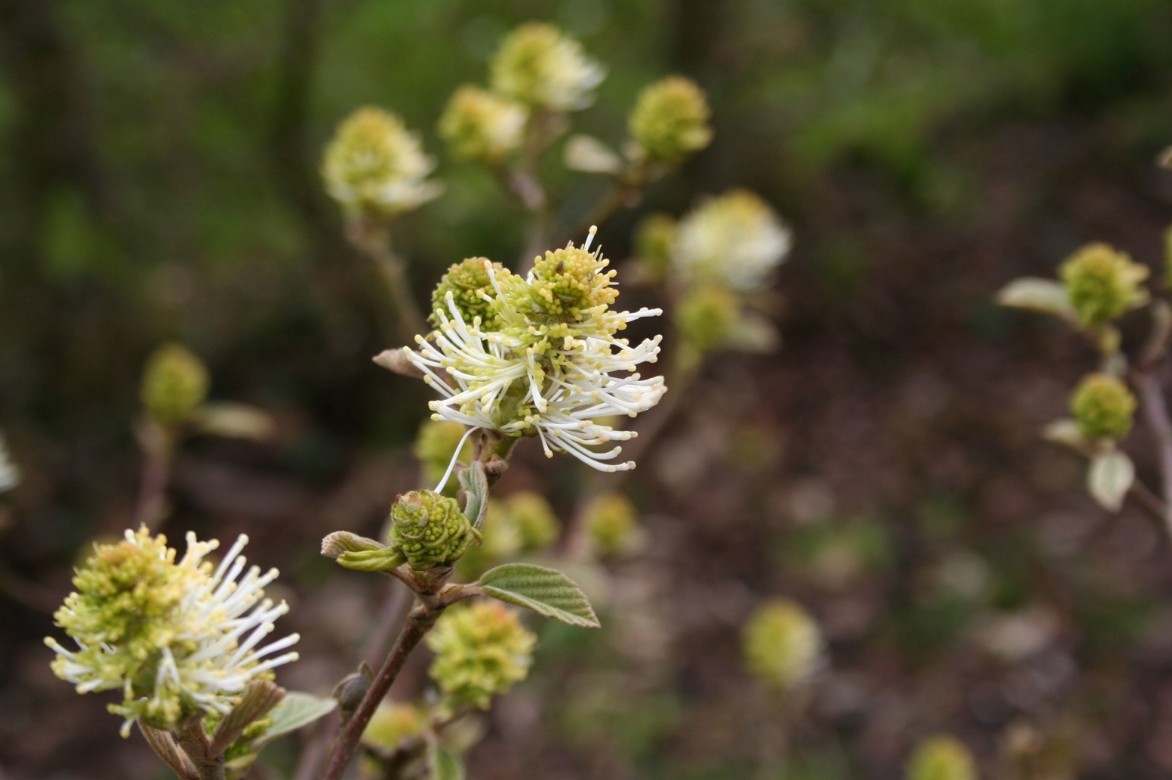
Fothergilla major just starting to flower
Multiplication
Sowing is possible with seeds harvested from a specimen at least two years old, because they will only germinate after experiencing two winters. We recommend favouring cuttings in summer on the tender wood of your Fothergilla.
By herbaceous cuttings
- In June, take shoots still tender, 10 to 20 cm long
- Remove all lower leaves and make a clean cut just below a node
- Plant cuttings in well-draining compost
- Keep moist, covered and in shade
- Pot up into buckets as soon as they have formed roots
- Keep them frost-free until following spring, then plant out in ground or into pots
By layering or taking suckers
The Fothergilla tends to produce suckers and to spread by stolons naturally: propagation is possible by taking a rooted sucker in early spring and simply replanting it in non-calcareous soil. Layering is also an option but rather slow given the slow root development of this bush.
Associate
With its immaculate white flowering and fiery foliage, the Fothergilla is essential to enliven garden in spring and autumn. It finds its place in a romantic garden and in white gardens, to which it will bring plenty of light.
Preferring acidic soils, it pairs easily in a loose hedge or a cool border with ericaceous plants such as Hamamelis, Magnolia, Pieris, ferns, Kalmias, deciduous Azaleas, Hydrangeas, Camellias, Rhododendrons, Sarcococca or Daphnes that will flower before it or take over its flowering.
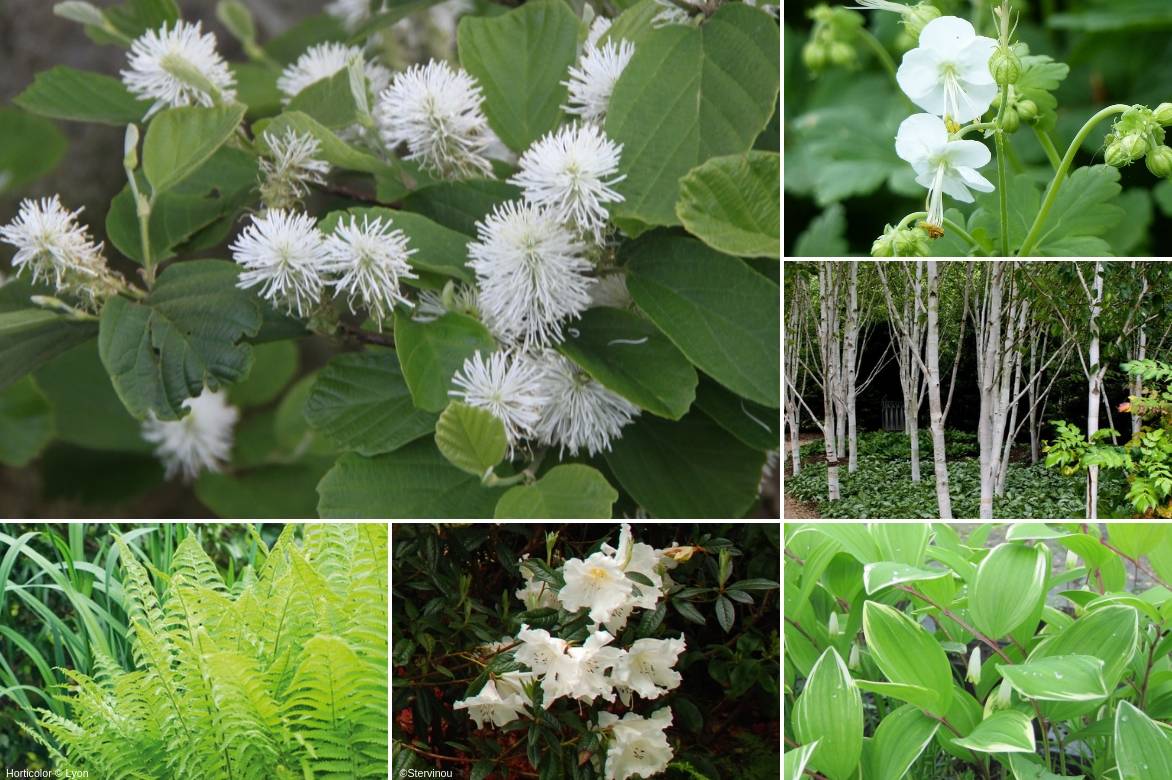
An idea for a planting in a light understorey on acidic soil: Fothergilla major, Geranium macrorrhizum ‘White Ness’, Polygonatum falcatum ‘Variegatum’, Rhododendron fragrantissimum, Matteuccia struthiopteris beneath cover of Betula utilis var. jacquemontii
In spring, its flowers are superb alongside spring-flowering perennials such as bleeding hearts, melittis, Solomon’s seal, tiarellas, primroses, Hellebores, Hostas.
Dress base of bush with winter heathers, brunneras, campanulas or spring bulbs such as tulips and daffodils.
Later, its foliage in flamboyant hues will blend with other bushes with autumn-coloured foliage such as Japanese maples, barberries, dogwoods, deciduous Euonymus, Lindera, sumacs and with some perennials such as love-in-a-mist and chrysanthemums of group Rubellum.
Useful resources
- All the secrets to successfully planting your Fothergilla are in our video!
- They prefer acidic soil that remains moist even in summer; discover the most beautiful heather soil bushes!
- Fancy other bushes with autumn-coloured foliage? Let our collection tempt you!
Frequently asked questions
-
My Fothergilla's leaves are yellowing, why?
Too calcareous soils cause this bush to develop leaf yellowing called chlorosis, which often ends up killing it. If worrying yellowing appears, transplant it into soil enriched with heather soil and potting compost, or into a pot; if your soil is really too calcareous, opt for another bush less sensitive to calcareous soil.
- Subscribe!
- Contents
































Comments